Principles for high-viscosity mixing

Liquid mixing processes are used in a wide range of industries to produce an even wider range of products.
In practice, most industrial mixing processes feature low-viscosity fluids — i.e., those that move easily when agitated and continue to flow after agitation is removed, as opposed to high-viscosity fluids which do not flow easily, if at all, unless directly driven by mechanical means.
There is much more flexibility in designing mixing equipment for low-viscosity applications, while high-viscosity applications present more challenges. Understanding the unique needs of high-viscosity mixing is critical for businesses to ensure they have the right equipment for their needs.
What is high viscosity?
The degree to which a fluid resists continual movement when subjected to shear force such as from a mixing impeller is primarily determined by its viscosity.
Viscosity values can be provided by liquid ingredient producers on their product data sheets or they can be determined using multiple types of test equipment with results provided in various units of measure. Centipoise (cps) is one common unit of measure with 1 centipoise being the viscosity of water. Extreme viscosities for products such as asphalt that almost completely resist flow can exceed 250,000 cps and we have even seen examples of some printing ink formulations that exceeded 1,000,000 cps. These application types are the least common and require highly specialized equipment designs.
Although there is not a standard viscosity value that determines an application to be “high viscosity,” for practical purposes we will consider it to be relatively so when achieving continual flow throughout a mixing vessel requires significant assistance to remain in motion. In general, as viscosity increases the resulting flow becomes more laminar than turbulent, increasing the importance of appropriate mixer design to achieve a desired agitation level or mixture homogeneity. Some common and varying degrees of higher viscosity mixing applications are the blending of heavy paints or primers in the coatings industry, the production of food products such as condiments or peanut butter, and the aforementioned pigmentation of printing inks.
High-viscosity mixing components
For high-viscosity mixing applications, the importance of torque and the mixing impeller type and diameter are paramount to mixing success. For example, direct-drive motors with rotational speeds over 1,000 rpm driving small mixing impellers may adequately agitate water-like materials in mixing tanks of significantly large volume. However, this same arrangement will not produce the needed pumping capacity or flow pattern in the mixing vessel with more viscous formulations.
Mixers that feature a gearbox to reduce the rpm produced by the motor while greatly increasing its torque output produce better results for high-viscosity mixing. This increase in torque means that mixer shaft diameters must be larger in order to drive impellers that can exceed half the tank diameter. Common mixing tank configurations typically require three-blade axial turbine or four-blade axial turbine impeller types which have broad blades and an aggressive pitch to maximize the contact surface area during the mixing process.
Container types and applications
Liquid production facilities perform mixing operations in containers that range from less than one gallon to thousands of gallons, and industrial mixing equipment providers offer mixer designs to accommodate many different container types. Common container types include 5-gallon pails, 55-gallon drums, plastic and stainless steel 275-gallon bulk containers or “totes,” and open- or closed-top mixing tanks from tens to thousands of gallons.
One recent application was for a producer of nut butters and other food products in 5-gallon batches. A benchtop pneumatic lift style mixer was a great option to provide the necessary torque for effective blending while stabilizing the container to prevent unwanted rotation. A portable gear-driven 5-gallon pail mixer was the right choice for another customer for on-site use with roof coatings. For much larger batches recent customers chose top-mounted tank mixers to produce liquid truck bed liner formulations, gel coatings for fiber glass swimming pools and organic shampoos with each mixer configured specifically for the unique fluid properties and to meet various operational environments and applicable industry standards.
No matter the container type used, or whether it’s one gallon or 1,000, high-viscosity liquids require specific, and often customized, solutions to ensure proper mixing. When in doubt, always consult the mixer manufacturer with all of the project parameters.
Mark Hennis is the President of INDCO, which manufactures various types of industrial mixers for a wide range of industries and applications. He holds a BS in Mechanical Engineering from the University of Tennessee and has served as the President of INDCO since 2010. For more information on INDCO visit www.INDCO.com.
About the Author

Mark Hennis
President of INDCO
Mark Hennis is the President of INDCO, Inc., a manufacturer of industrial mixing equipment located in New Albany, Indiana. He holds a B.S. in mechanical engineering from the University of Tennessee. Since 1975, INDCO has designed and manufactured a complete lineup of mixers for batch sizes up to 50,000 gallons. More information is available at www.INDCO.com, by calling (800) 851-1049, or via email at [email protected].
